Compsognathidae
|
The Compsognathidae are primitive members of the Coelurosauria, the clade of theropods that includes all of the remaining groups covered below. This group is characterized by the presence of either simple protofeathers or more complex feathers (feathers may also be present in other theropods, but there has been no direct evidence for any non-coelurosaurs).
Compsognathus sp., like other members of this family, are small, agile dinosaurs. The exact makeup of this family, and their relationships to other coelurosaurs, is still debated. Reconstructed skeleton.
Taxonomy: Theropoda, Coelurosauria, Compsognathidae
Europe
Late Jurassic Period, 150 Ma
Museum of Ancient Life, Utah
|
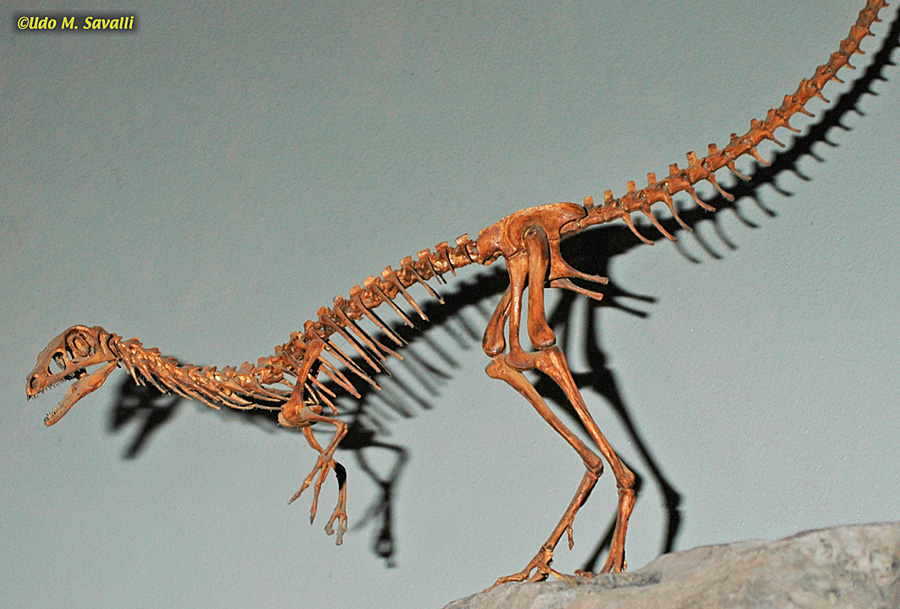
|
|
|
Compsognathus longipes fossil cast.
Taxonomy: Theropoda, Coelurosauria, Compsognathidae
Solnhofen, Germany
Late Jurassic Period, 150 Ma
New Mexico Museum of Natural History & Science
|
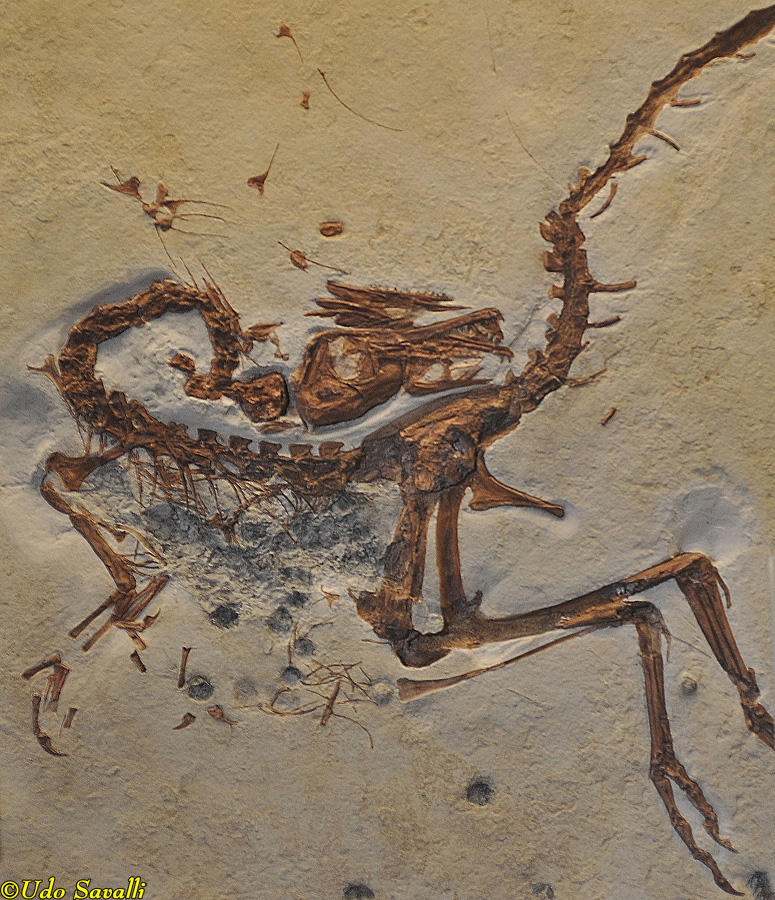
|
|
|
Cast of Scipionyx samniticus fossil of a juvenile (possibly only a few days old) that preserved some internal structures (by 3D mineralization rather than impressions, including trachea, liver, stomach, intestine, muscles, and claw sheaths.
Taxonomy: Theropoda, Coelurosauria, Compsognathidae
Italy
Early Cretaceous, Albian Stage
Black Hills Institute Museum, South Dakota
|
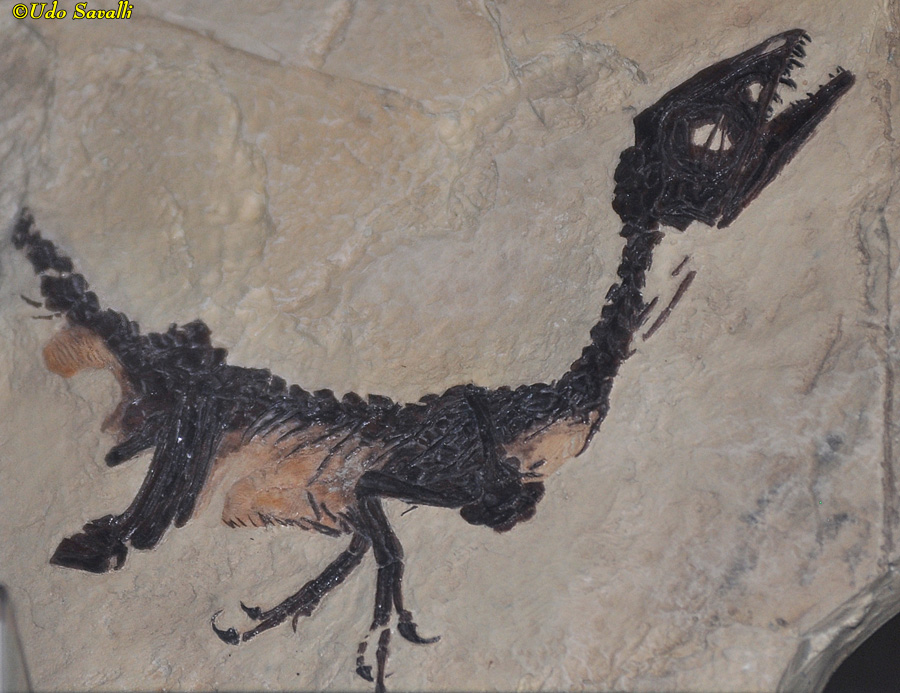
|
|
|
Life model of Compsognathus sp. It should probably be covered in simple filamentous feathers.
Taxonomy: Dinosauria; Therapoda; Compsognathidae
Late Jurassic Period, 150 Ma; Europe
Museum of Ancient Life, Utah
|
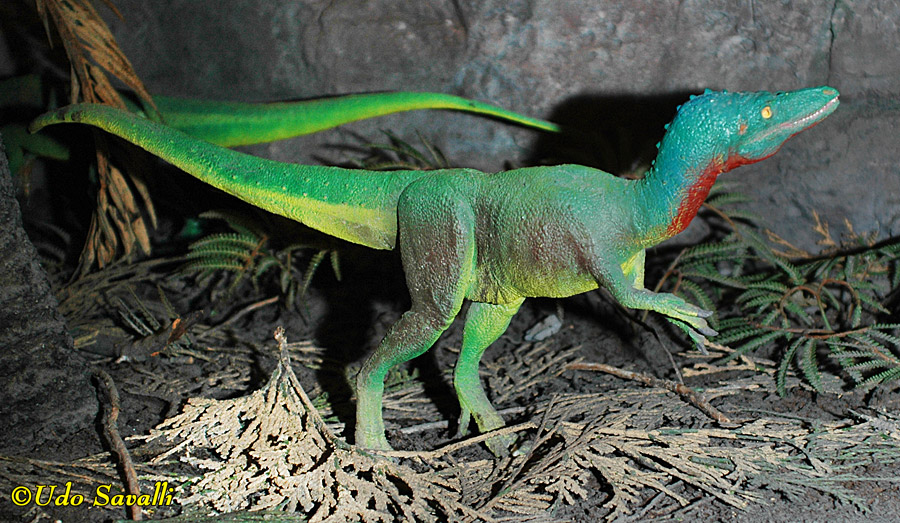
|
|
|
Life model of Sinosauropteryx prima, the first dinosaur to be discovered covered in filamentous proto-feathers. In life, it was likely a tawny or buffy coloration with darker brown bands on its tail and a dark mask on its face.
Taxonomy: Dinosauria; Therapoda; Compsognathidae
Early Cretaceous Period, 130-125 Ma; China
Fernbank Museum of Natural History, Georgia
|
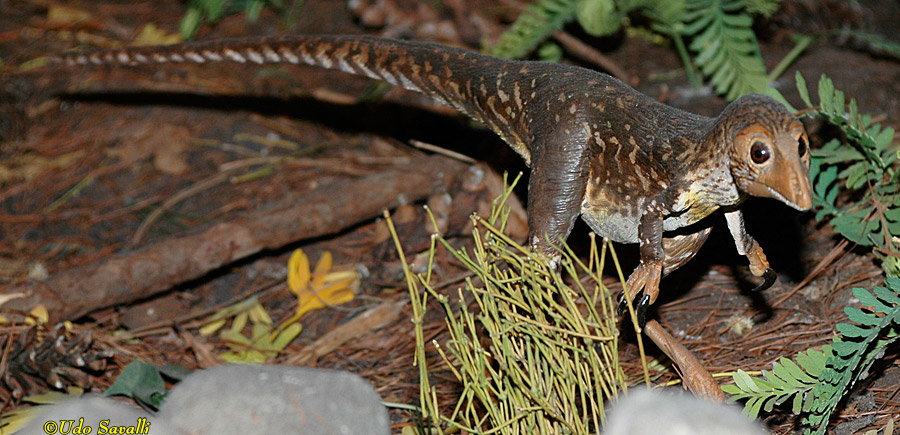
|
|
Tyrannosauroidea
|
The Tyrannosauroidea is famous for its most derived members, but the more ancestral members of this groups were small, three-fingered, fairly long-armed dinosaurs similar to the Compsognathids. Some of these ancestral forms had simple "protofeathers." They had blunt tips to their snouts and had a distinct type of nipping tooth on the premaxillary bones.
Suskityrannus hazelae was formally described in 2019.
Taxonomy: Theropoda, Tyrannosauroidea, Basal Tyrannosauroids
Zuni Basin, New Mexico
late Cretaceous Period, 92 Ma
Arizona Museum of Natural History
|
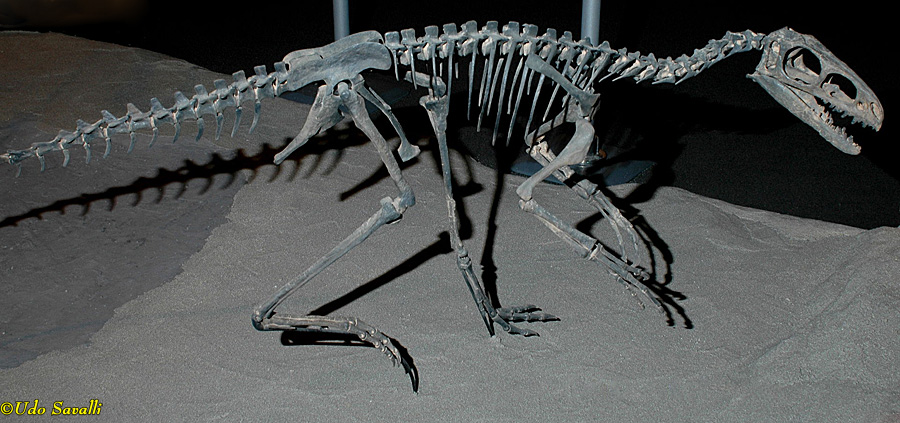
|
|
|
The exact evolutionary position of Tanycolagreus sp. is debated: it may be a basal Tyrannosauroid.
Taxonomy: Theropoda, Coelurosauria
Morisson Formation, western North America
Late Jurassic Period, 153-150 Ma
Museum of Ancient Life, Utah
|
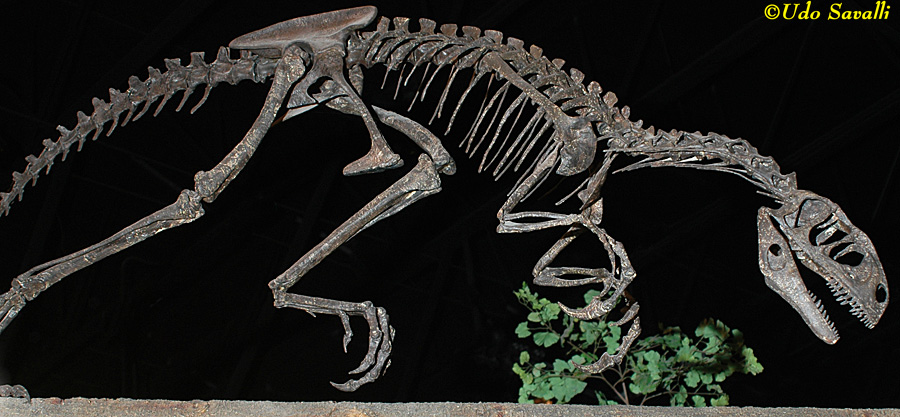
|
|
|
Life model of Dilong paradoxus, a small primitive relative of Tyrannosaurus and known to be covered in filamentous feathers.
Taxonomy: Dinosauria; Therapoda; Tyrannosauroidea
Early Cretaceous Period, 130-125 Ma; China
Fernbank Museum of Natural History, Georgia
|
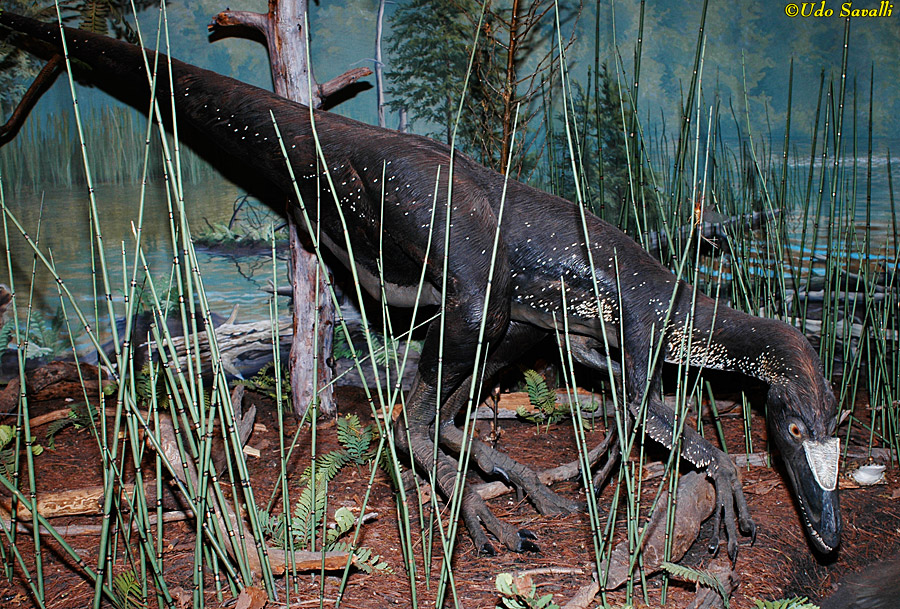
|
|
|
The derived Tyrannosauridae are all very large predators with big heads and greatly reduced arms with only 2 fingers.
Albertosaurus sarcophagus is a fairly typical tyrannosaurid. It was about 9-10 m long.
Taxonomy: Theropoda, Tyrannosauroidea, Tyrannosauridae
Western North America
Late Cretaceous Period, 73-70 Ma
San Diego Natural History Museum
|
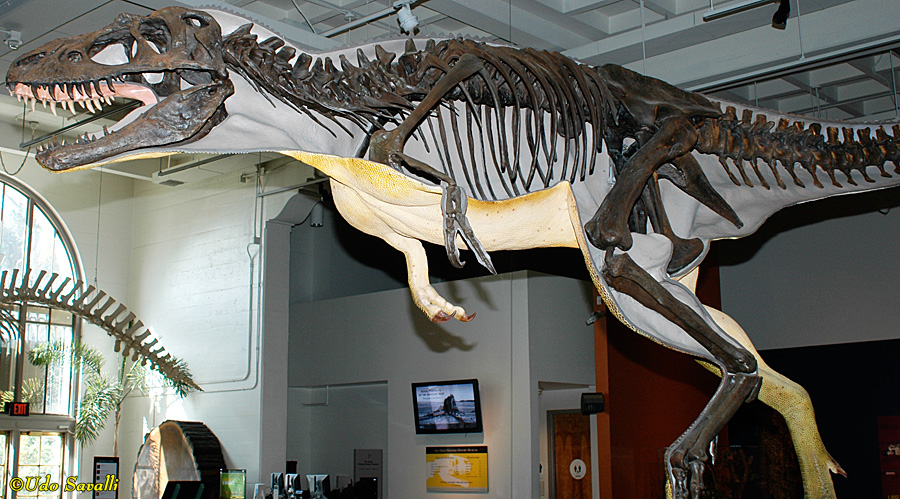
|
|
|
Gorgosaurus libratus is closely related to Albertosaurus (above), and is sometimes placed in that genus.
Taxonomy: Theropoda, Tyrannosauroidea, Tyrannosauridae
Two Medicine Formation, Teton Co., Montana
Late Cretaceous, Campanian Stage
Black Hills Institute Museum, South Dakota
|
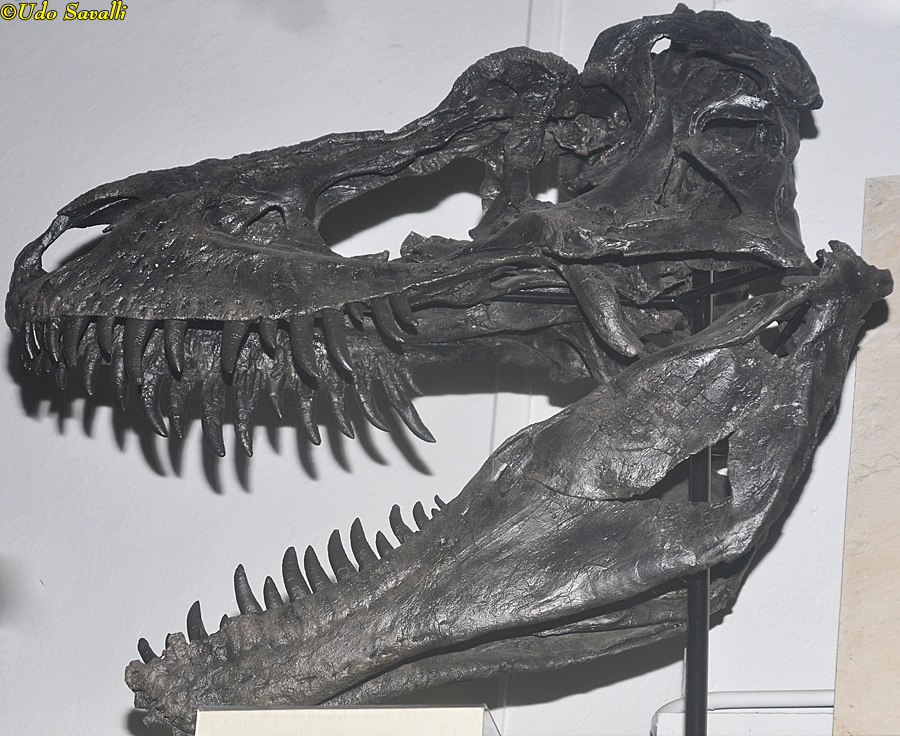
|
|
|
Tarbosaurus bataar is a close relative of Tyrannosaurus rex. This specimen is a subadult.
Taxonomy: Theropoda, Tyrannosauroidea, Tyrannosauridae
Asia
Late Cretaceous Period, 70 Ma
Arizona Museum of Natural History
|
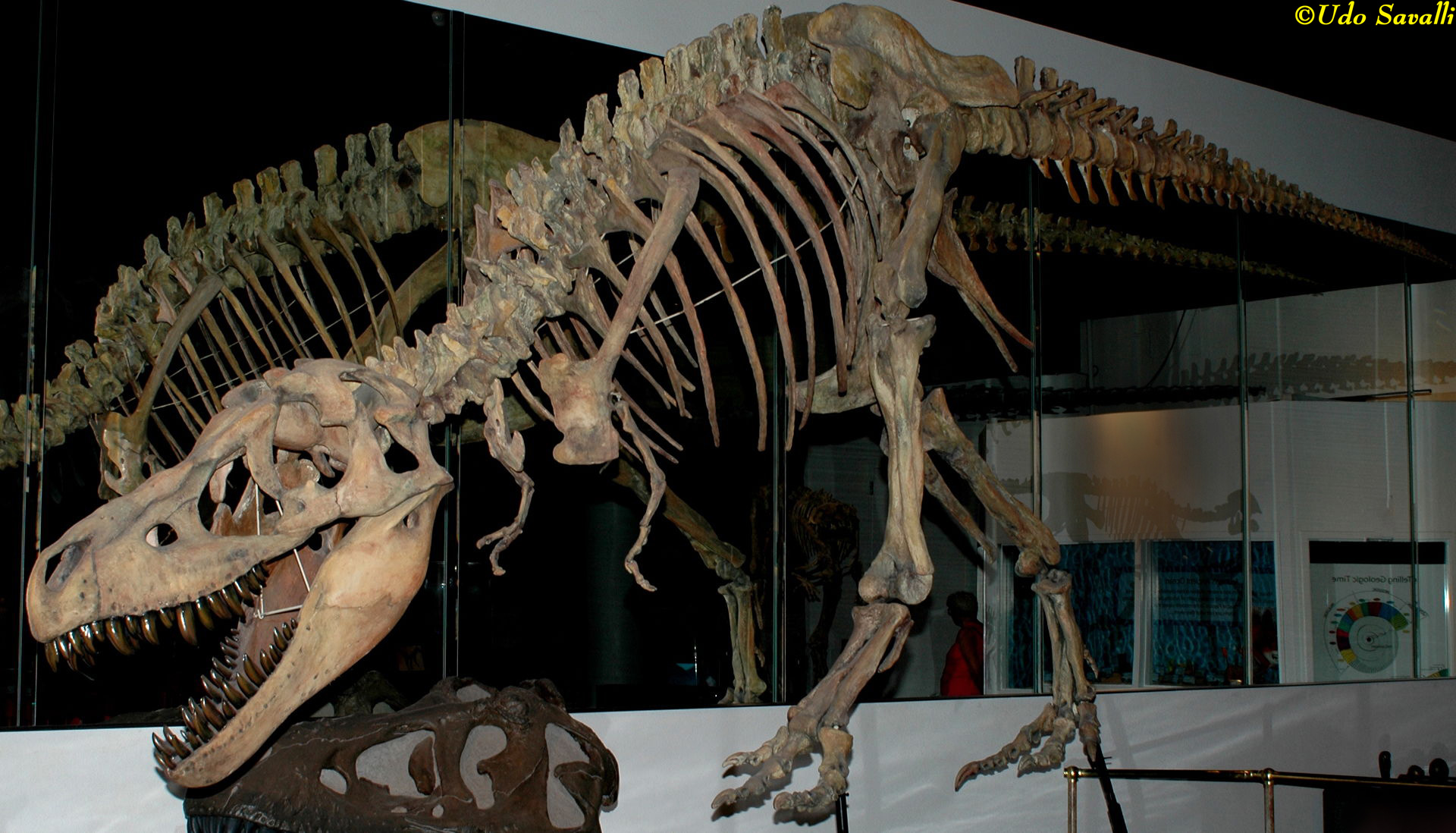
|
|
|
Bistahieversor sealeyi skull.
Taxonomy: Theropoda, Tyrannosauroidea, Tyrannosauridae
Kirtland Formation, New Mexico
Late Cretaceous Period, 75 Ma
New Mexico Museum of Natural History & Science
|
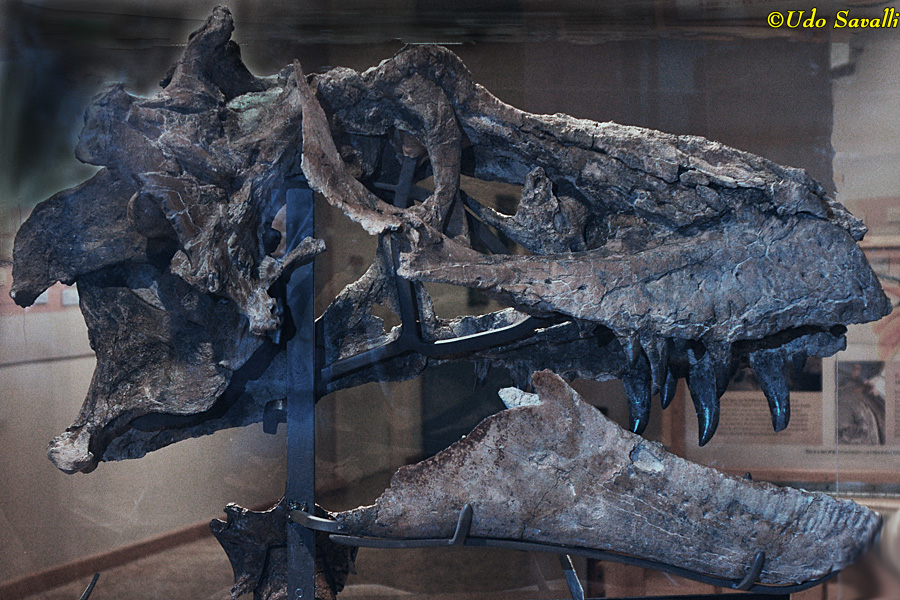
|
|
|
Alioramus sp. was a long-snouted tyrannosaur (skull cast).
Taxonomy: Theropoda, Tyrannosauroidea, Tyrannosauridae
Nemegt Beds, Mongolia
Late Cretaceous Period, Maastrichtian Stage, 68 Ma
Wyoming Dinosaur Center
|
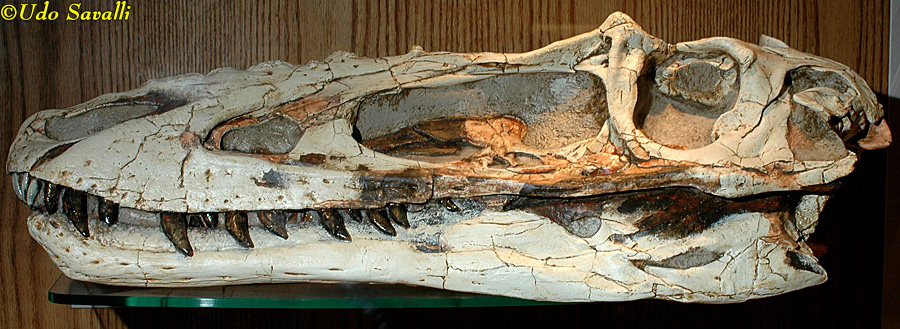
|
|
|
Appalachiosaurus montgomeriensis is a basal member of the Tyrannosauridae or lies just outside this family. It is one of the few late Cretaceous dinosaurs from the eastern United States.
Taxonomy: Theropoda, Tyrannosauroidea, Tyrannosauridae?
Demopolis Chalk Formation, southeastern United States
Late Cretaceous Period, 77 Ma
Rocky Mountain Dinosaur Resource Center, Colorado
|
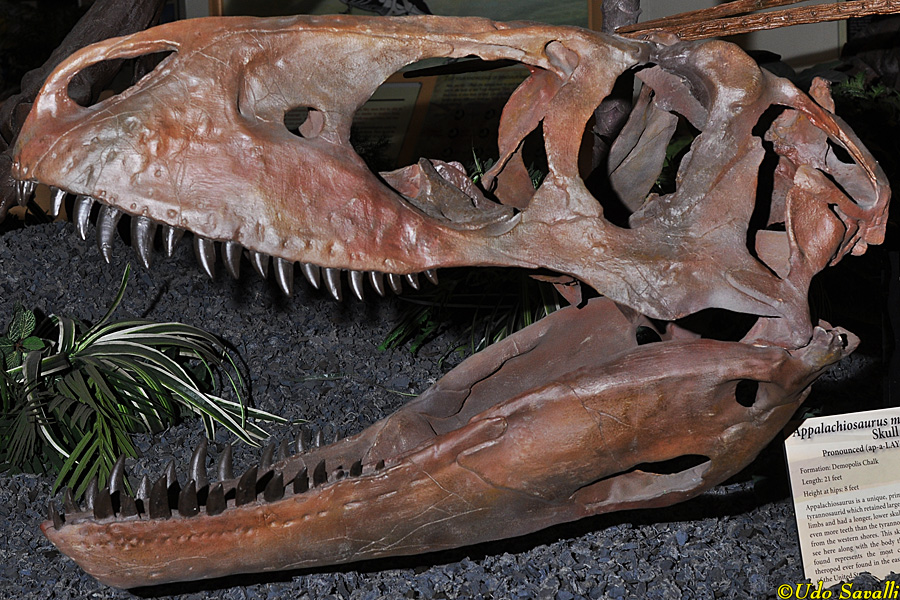
|
|
|
The skulls of tyrannosaurids changed considerably as they grew. These two skulls are from Daspletosaurus horneri, with the adult (holotype) at left and a late juvenile or subadult on the right.
Taxonomy: Theropoda, Tyrannosauroidea, Tyrannosauridae
Glacier Co., Montana
Late Cretaceous Period
Museum of the Rockies, Montana
|

|
|
|
Nanotyrannus lancensis is one of the most controversial dinosaurs, as many researchers believe it to be a juvenile Tyrannosaurus rex (see below). Although its skull (this is a cast of the holotype, the specimen used to name this species) is quite different from adult T. rex, other Tyrannosaurids show considerable change in the shape of the skull and the shape and number of teeth as they grew. More complete specimens may be needed to settle the debate.
Taxonomy: Theropoda, Tyrannosauroidea, Tyrannosauridae
Hell Creek Formation, Carter Co., Montana
Late Cretaceous, Upper Maastrichtian Stage
Black Hills Institute Museum, South Dakota
|
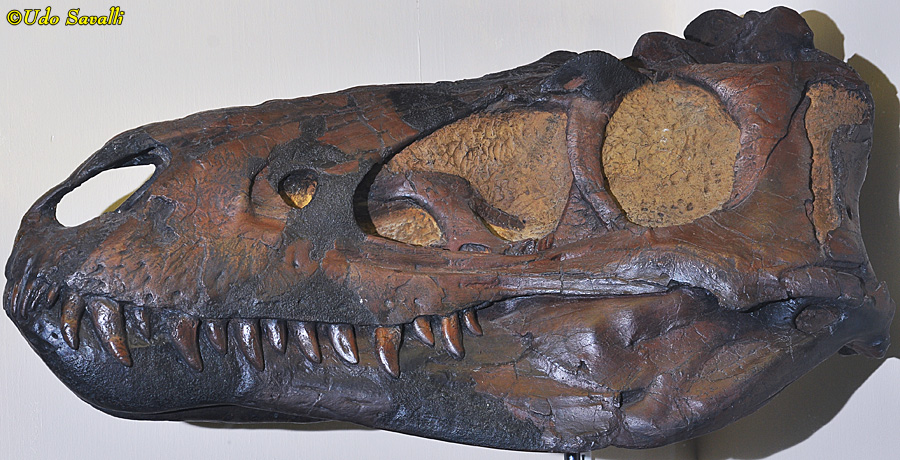
|
|
|
Tyrannosaurus rex is one of the most familiar and popular dinosaurs. It is the largest member of the Tyrannosauridae, about 12.5 m long. It had an exceptionally strong bite and its thick teeth were adapted for crushing bone.
Taxonomy: Theropoda, Tyrannosauroidea, Tyrannosauridae
Western North America
Late Cretaceous Period, Maastrichtian Stage, 67-66 Ma
Museum of Ancient Life, Utah
|
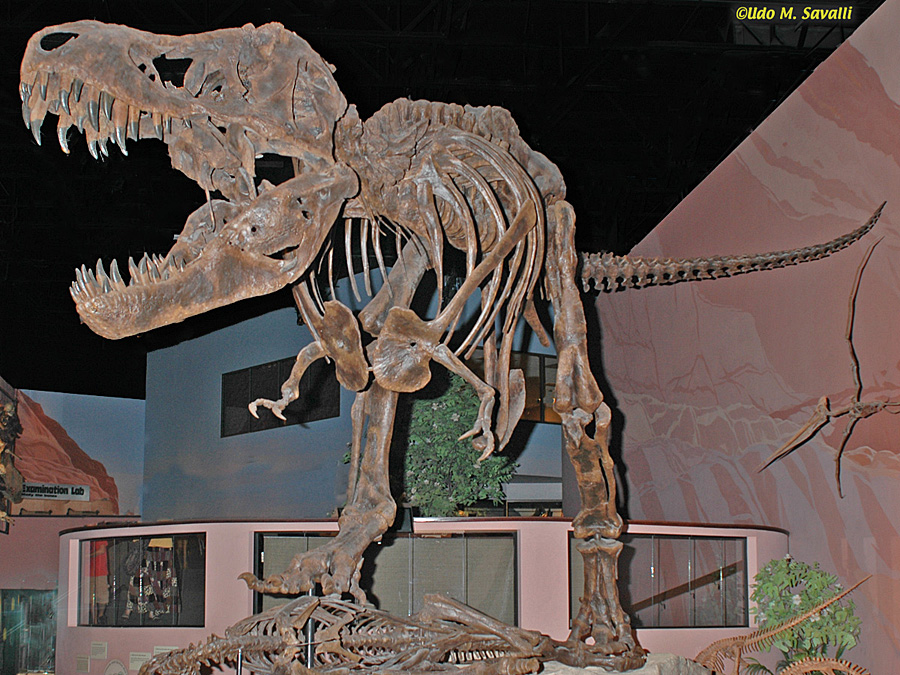
|
|
|
Tyrannosaurus rex skeleton with 60% real bone; replicated material in lighter color.
Taxonomy: Theropoda, Tyrannosauroidea, Tyrannosauridae
Hell Creek Formation, McCone Co., MT
Late Cretaceous Period, Maastrichtian Stage, 67-66 Ma
Museum of the Rockies, Montana
|
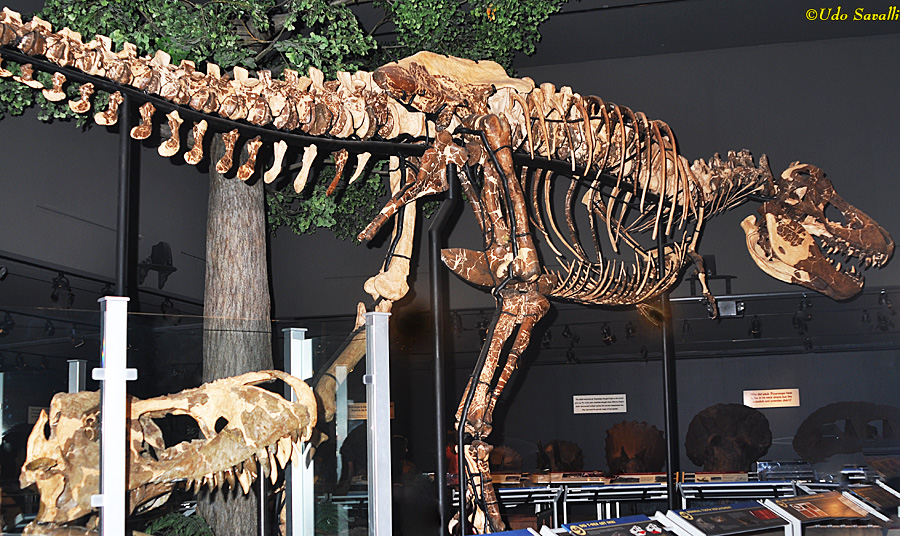
|
|
|
Adult Tyrannosaurus rex with juvenile (brown) and baby (tan) reconstructed skeletons. The juvenile is probably based on Nanotyrannus (which could be a juvenile T. rex) while the baby is based on a skull fragment now thought to belong to Daspletosaurus. Post-cranial remains are not well known for young T. rex so these skeletons are mostly extrapolated from young Tarbosaurus skeletons.
Taxonomy: Theropoda, Tyrannosauroidea, Tyrannosauridae
Montana
Late Cretaceous Period, Maastrichtian Stage, 67-66 Ma
Los Angeles Museum of Natural History
|
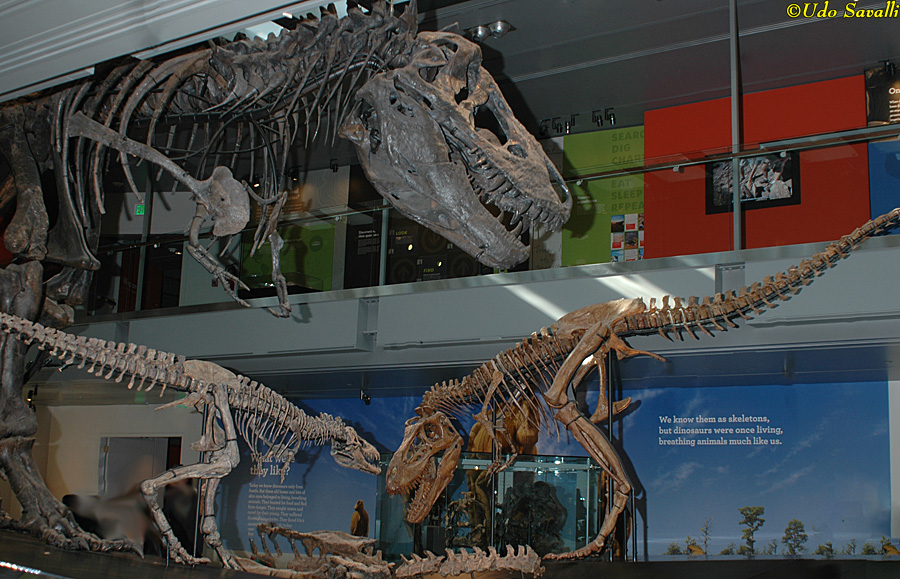
|
|
|
Tyrannosaurus rex skull growth series. The far left baby ("Chomper") is extrapolated from just a few skull pieces using a more complete 2-3 year old skull of Tarbosaurus as a guide. The juvenile 2nd from left is "Jane" which some researchers consider a separate species, Nanotyrannus lancensis. The third skull if from a gravid (pregnant but with eggs) female (determined by the presence of "medullary bone" that develops during egg laying in birds and some dinosaurs).
Taxonomy: Theropoda, Tyrannosauroidea, Tyrannosauridae
Montana
Late Cretaceous Period, Maastrichtian Stage, 67-66 Ma
Museum of the Rockies, Montana
|

|
|
|
Life model of Albertosaurus sp.
Taxonomy: Dinosauria; Therapoda; Tyrannosauroidea; Tyrannosauridae
Late Cretaceous Period, 73-70 Ma; Western North America
San Diego Natural History Museum
|
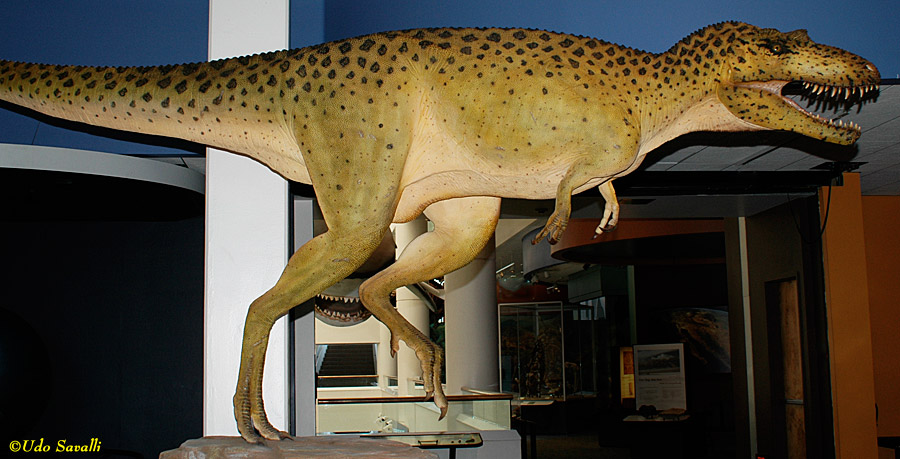
|
|
|
Life model of Daspletosaurus sp.
Taxonomy: Dinosauria; Therapoda; Tyrannosauroidea; Tyrannosauridae
Late Cretaceous Period
Dinosaur Resource Center, Colorado
|
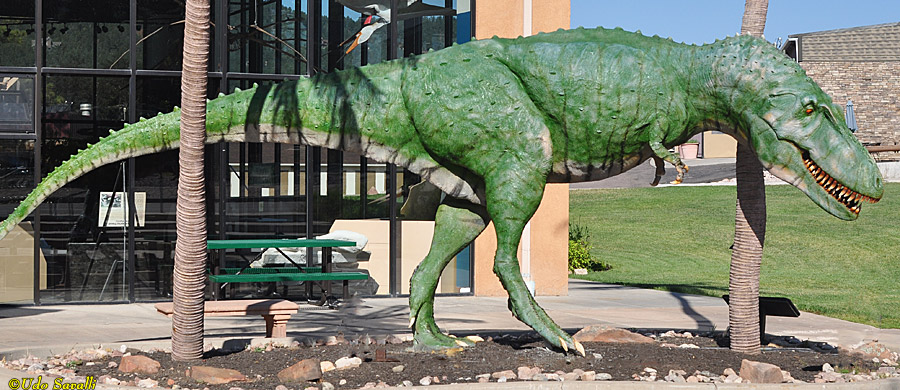
|
|
Ornithomimids
|
The ornithomimids are commonly referred to as the ostrich-mimics, and indeed, they resemble these large flightless birds. They have long legs with long tarsal bones to increase stride length (indicating they were probably fast runners), fairly long arms, long necks and small heads with (in most) toothless beaks. They are believed to have been herbivorous or omnivorous.
Struthiomimus sp. is a typical derived ornithomimid.
Taxonomy: Theropoda, Coelurosauria, Ornithomimidae
Western North America
Late Cretaceous Period, 75-66 Ma
Museum of Ancient Life, Utah
|
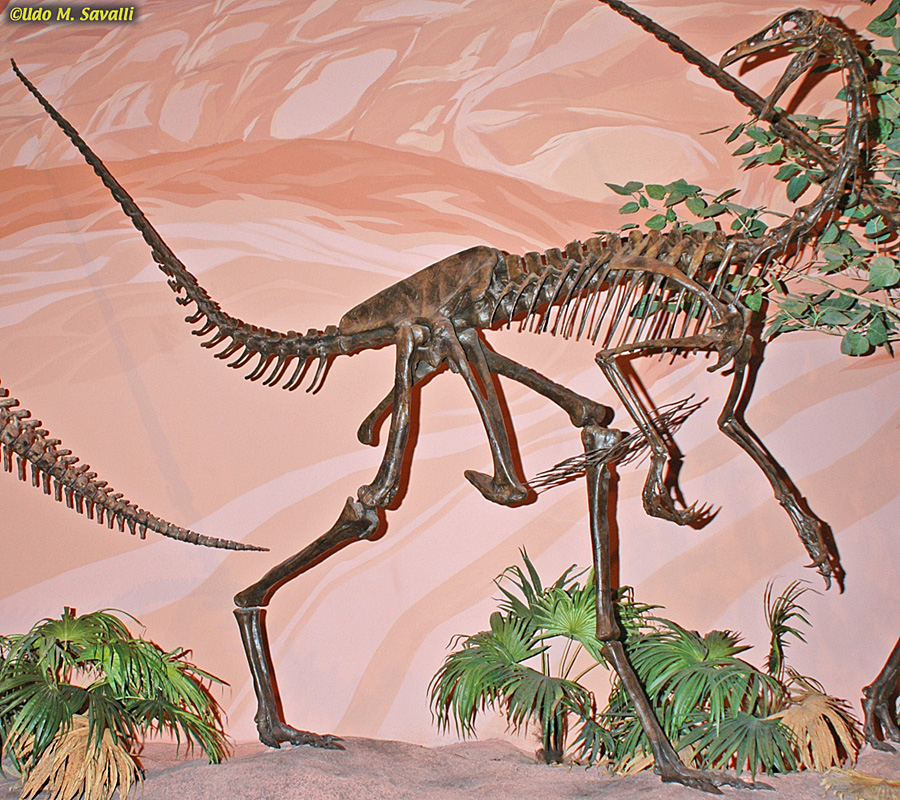
|
|
|
Struthiomimus sedens fossil (head & neck have been restored).
Taxonomy: Theropoda, Coelurosauria, Ornithomimidae
Lance Formation, Niobrara County, WY
Late Cretaceous Period
Black Hills Institute Museum, South Dakota
|
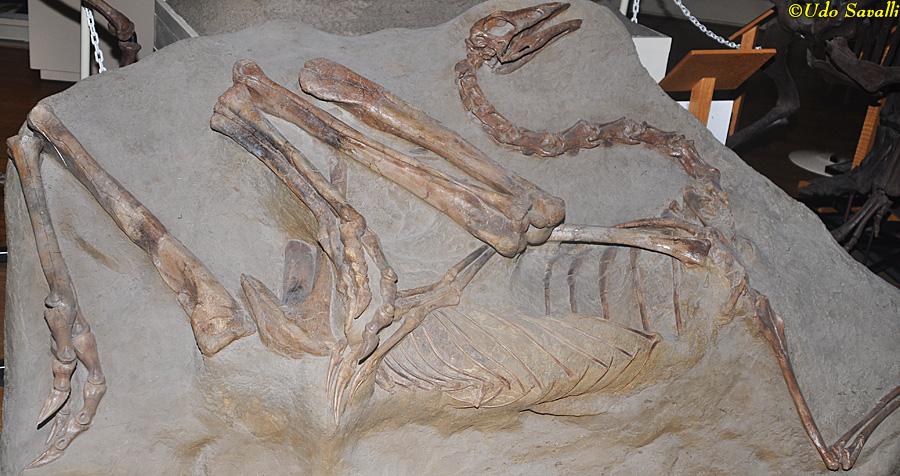
|
|
|























